#image annotation for Machine Learning
Explore tagged Tumblr posts
Text
Image Annotation Services: The Subtle Art of Bringing Visual Data to Life
Dive into the nuanced world of image annotation services in this blog, exploring the intricate process of breathing life into visual data. Delve into the artistry behind annotating images with precision, enhancing machine learning algorithms. Discover the subtleties that elevate raw visuals into rich, annotated datasets, revolutionizing the realm of Computer Vision. Read the blog:…

View On WordPress
#Image Annotation Company#image annotation for Machine Learning#Image Annotation Outsourcing#Image Annotation Services
0 notes
Text
Maximizing Efficiency in AI Projects with Image Annotation Services
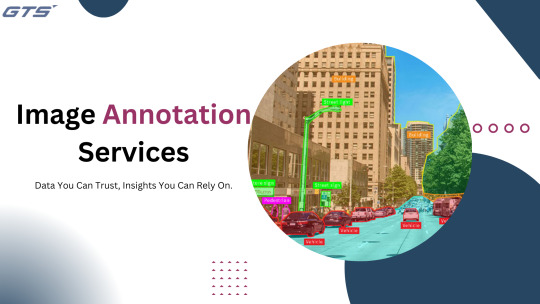
Introduction:
Artificial Intelligence (AI) has revolutionized numerous sectors by streamlining processes, enhancing decision-making capabilities, and improving user interactions. A fundamental component that underpins the effectiveness of any robust AI model is data preparation, particularly through image annotation. As the demand for AI applications, especially in the realm of computer vision, continues to expand, the significance of image annotation services becomes increasingly critical in optimizing the performance and precision of AI initiatives.
This article will delve into the significance of image annotation services, the various forms of image annotations, and how these services can greatly enhance the results of AI projects.
Comprehending Image Annotation Services
Image Annotation Services refers to the process of labeling images or specific objects within those images to render them understandable to AI systems. This involves assigning meaningful tags to raw images, enabling AI technologies to interpret, identify, and categorize visual information. Annotation tasks can range from recognizing and classifying objects in images to delineating specific boundaries, points, or areas of interest.
These annotations serve as the essential "ground truth" for AI and machine learning algorithms, making them vital for developing models capable of executing intricate tasks such as object detection, facial recognition, and medical imaging analysis.
The Importance of Image Annotation Services for AI Projects
Although image annotation may appear straightforward, it demands a high level of accuracy, consistency, and specialized knowledge. Human annotators must grasp the subtleties of visual data and apply labels appropriately. Therefore, utilizing image annotation services is crucial for enhancing the efficiency of AI projects.
Precision in Model Training : AI models depend on precise data for effective predictions and classifications. Accurate image annotation is essential for ensuring that models learn from high-quality, well-labeled datasets, which enhances their performance. Inaccurate annotations can lead to misinterpretations by AI models, resulting in errors and inefficiencies within the system.
2. Enhanced Scalability : As AI initiatives expand, the demand for image annotation increases significantly. Delegating this responsibility to specialized image annotation services enables organizations to efficiently manage extensive datasets, thereby accelerating the training process without compromising quality. This scalability ensures that AI projects adhere to timelines and can accommodate growing data requirements.
3. Proficiency in Complex Annotation Tasks : Certain AI initiatives necessitate sophisticated annotation methods, such as pixel-level segmentation or 3D object detection. Professional image annotation services possess the expertise required to tackle these intricate tasks, guaranteeing that AI models receive the most precise and comprehensive annotations available.
4. Economic Viability : Establishing an in-house team of annotators for large-scale AI projects can incur substantial costs and require considerable time. Image annotation services offer a more economically viable alternative by providing access to a skilled workforce without the overhead expenses linked to hiring and training a complete team. This approach allows organizations to allocate resources to the primary aspects of their AI projects while outsourcing annotation tasks to experts.
5. Accelerated Time-to-Market : In the realm of AI projects, time is often a crucial element, particularly in competitive sectors. Image annotation services can dramatically reduce the time needed for image annotation, ensuring that AI models are trained swiftly and effectively. This expedited development cycle results in a quicker time-to-market for AI applications, providing businesses with a competitive advantage.
Types of Image Annotations
Various types of image annotations are employed in artificial intelligence projects, tailored to meet the specific requirements of each initiative. Among the most prevalent types are:
Bounding Boxes : Bounding boxes represent the most basic form of annotation, where annotators create rectangular outlines around objects within an image. This technique is frequently utilized in object detection tasks to instruct AI models on how to recognize and categorize objects present in images.
Polygonal Annotation : For objects with more complex shapes, polygonal annotation is utilized to delineate the exact contours of an object. This approach is particularly advantageous for irregularly shaped items or those with detailed boundaries, such as in satellite imagery analysis or medical imaging.
Semantic Segmentation : Semantic segmentation entails labeling each pixel in an image to categorize various regions. This annotation type is beneficial for applications that necessitate precise recognition, such as in autonomous driving or medical diagnostics.
Keypoint Annotation : Keypoint annotation consists of marking specific points within an image, such as facial landmarks in facial recognition tasks or joint locations in human pose estimation. This assists AI models in comprehending the relationships among different components of the image.
3D Cubes and LIDAR Annotation : In sophisticated AI applications, particularly in the realm of autonomous vehicles, 3D annotation techniques are employed. This involves labeling three-dimensional objects or utilizing LIDAR data to aid AI systems in understanding spatial relationships within a three-dimensional environment.
Advantages of Delegating Image Annotation to Experts
Although managing image annotation internally may appear viable, there are numerous advantages to entrusting this task to specialized services:
Uniformity and Standardization : Expert services employ established annotation protocols and tools to guarantee that each image is annotated uniformly. This uniformity is essential for training machine learning models, as discrepancies in annotations can adversely impact model performance.
Accelerated Turnaround : Delegating annotation tasks enables quicker completion of AI projects. Professional services are equipped to manage extensive datasets and can deliver high-quality annotations in a timely manner, thereby expediting the model training phase.
Access to Cutting-Edge Tools and Technology : Image annotation providers frequently utilize sophisticated software and tools that enhance both the efficiency and precision of the annotation process. These tools may feature capabilities such as auto-tagging, collaborative workflows, and quality assurance mechanisms to optimize the annotation workflow.
Quality Assurance and Error Identification : Reputable image annotation services implement rigorous quality control measures to identify and rectify errors. This minimizes the risk of incorrect labels impacting the training of the AI model, thereby contributing to the overall success of the AI initiative.
Conclusion
Image annotation services are vital for improving the efficiency and effectiveness of AI projects. By outsourcing the annotation process to professionals, organizations can ensure the precision, scalability, and rapidity of their AI systems. These services not only enhance the quality of training data but also assist companies in saving time, lowering costs, and maintaining a competitive advantage in the swiftly evolving landscape of AI technologies.
Investing in professional image annotation services represents a prudent decision for any organization aiming to fully harness the potential of AI.Whether you’re working on autonomous driving, facial recognition, or any other computer vision project, image annotation will be a key factor in maximizing your AI project’s efficiency and success.
Image annotation services play a pivotal role in maximizing the efficiency of AI projects by providing high-quality, labeled data that enhances the accuracy of machine learning models. Partnering with experts like Globose Technology Solutions ensures precise annotations tailored to specific project needs, driving faster development cycles and more effective AI solutions. The right image annotation strategy accelerates project timelines, optimizes resource allocation, and ultimately empowers businesses to achieve their AI goals with greater precision and efficiency.
0 notes
Text

0 notes
Text
1 note
·
View note
Text
0 notes
Text

Hello there,
I'm Md. Maruful Islam is a skilled trainer of data annotators from Bangladesh. I currently view my job at Acme AI, the pioneer in the data annotation sector, as an honour. I've improved my use of many annotation tools throughout my career, including SuperAnnotate, Supervise.ly, Kili, Cvat, Tasuki, FastLabel, and others.
I have written consistently good annotations, earning me credibility as a well-respected professional in the industry. My GDPR, ISO 27001, and ISO 9001 certifications provide even more assurance that data security and privacy laws are followed.
I genuinely hope you will consider my application. I'd like to learn more about this project as a data annotator so that I may make recommendations based on what I know.
I'll do the following to make things easier for you:
Services:
Detecting Objects (Bounding Boxes)
Recognizing Objects with Polygons
Key Points
Image Classification
Segmentation of Semantics and Instances (Masks, Polygons)
Instruments I Utilize:
Super Annotate
LABELBOX
Roboflow
CVAT
Supervised
Kili Platform
V7
Data Types:
Image
Text
Videos
Output Formats:
CSV
COCO
YOLO
JSON
XML
SEGMENTATION MASK
PASCAL VOC
VGGFACE2
#ai data annotator jobs#data annotation#image annotation services#machine learning#ai data annotator#ai image#artificial intelligence#annotation#computer vision#video annotation
0 notes
Text
📯 Find Reliable Image Annotation Companies for Your Data Labeling Needs
👀 Damco provides exceptional image annotation services that drive AI, Machine Learning, and data operation strategies. Image annotation entails the task of adding labels to an image, typically accomplished through a combination of human effort and occasionally aided by computer assistance. This crucial process plays a significant role in the development of Computer Vision models used for various tasks, including image segmentation, image classification, and object detection.
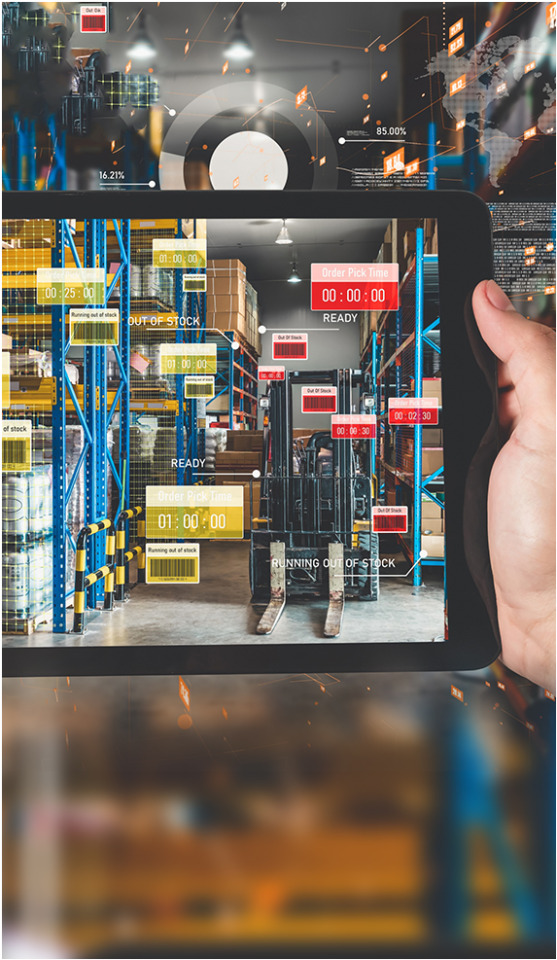
#image annotation services#outsource image annotation services#image annotation for the machine learning
0 notes
Text

0 notes
Text
Unveiling the Power of Image Annotation in Advancing AI
0 notes
Text
What is Annotation Ontology
Machine learning and computer vision applications require substantial training before deployment. Systems must learn to understand and recognize what they're looking at before reacting and executing functions. Whether in a healthcare setting or a warehouse, AI systems must understand the context surrounding the objects they see.
That's where ontology comes in. Ontologies provide more than top-level visual information about an object. They offer more detailed conceptual information, such as the relationships one object has to another or how it's represented in data. Also known as taxonomies or labeling protocols, ontologies play a big part in allowing you to semantically program computer vision and machine learning models to understand the complexities of the data they view.
It's what makes these intelligent systems capable of understanding complex information similarly to the human brain.
How Annotation Ontology Works
Think of how you recognize objects in your everyday life. If you see a dog walking on the street, you can easily define it as such. But you use tons of semantic information to get there. For example, you know how a dog relates to a cat, allowing you to differentiate the two animals. You can also use semantic information to see if that dog is a stray, separated from its owner or aggressive. All that information combines to help you learn about the dog you see. It's about using observations and drawing inferences from everything you see.
Computer vision and machine learning models need the same deep level of understanding to perform efficiently.
In annotation, ontologies are hierarchical structures that capture different levels of information. They allow for fine-grain differentiation and can provide more detailed annotations. It goes beyond top-level descriptors, including nested attributes to provide a more comprehensive understanding of the target object.
At the top of the hierarchy are classes or categories. They represent the highest level of concepts you want to express. Below that are nested classifications that go deeper into the object's attributes, for example, a top-level class could identify an object as a dog. Nested categories can then differentiate things like color, the presence of a collar, movement, speed, etc.
Read a similar article about rareplanes dataset here at this page.
#nifti image viewer#annotation services for computer vision#annotation ontology#what is meta training inference accelerator#custom annotation workflows#embeddings in machine learning#what is hitl
0 notes
Text

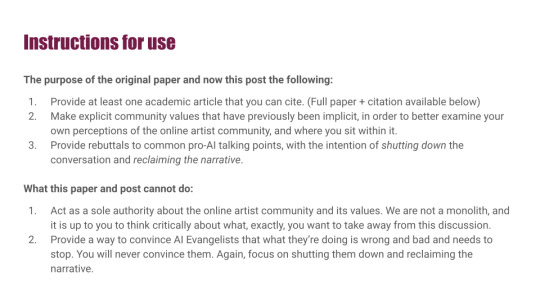
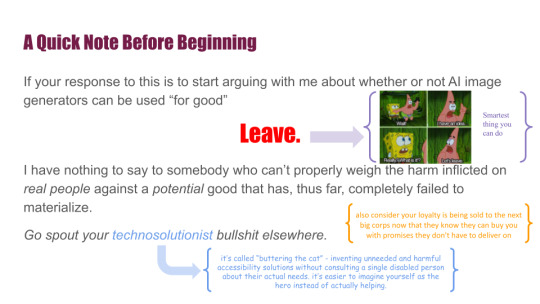
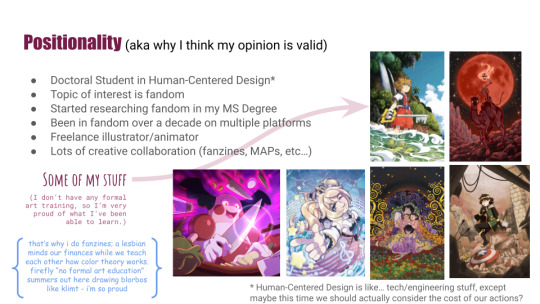
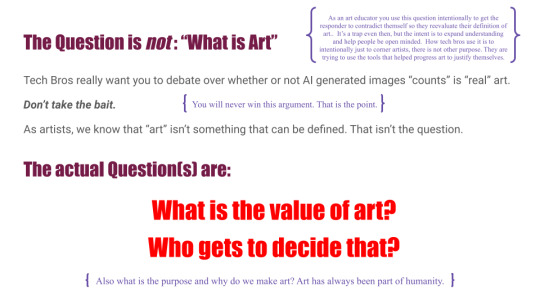
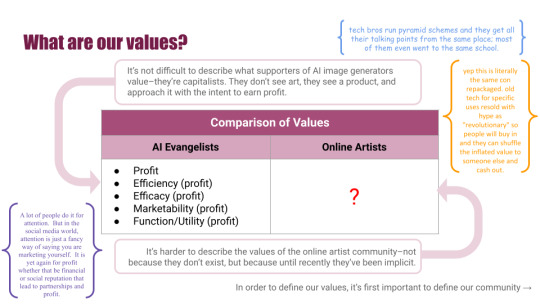
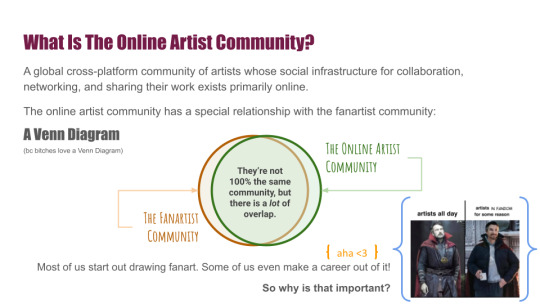
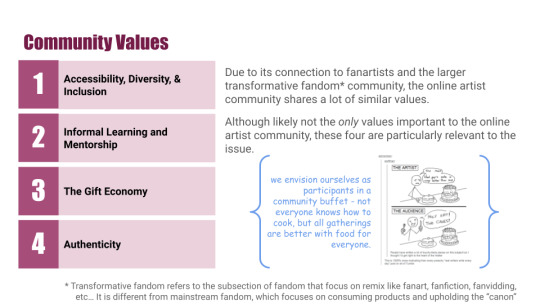
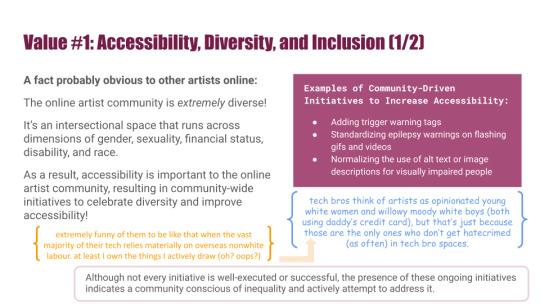
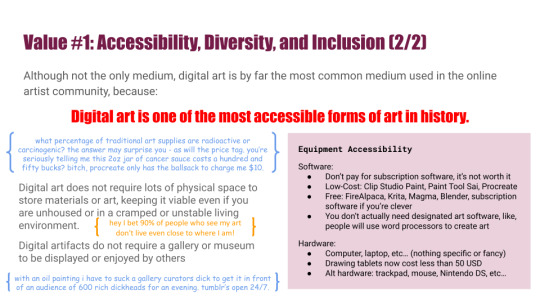
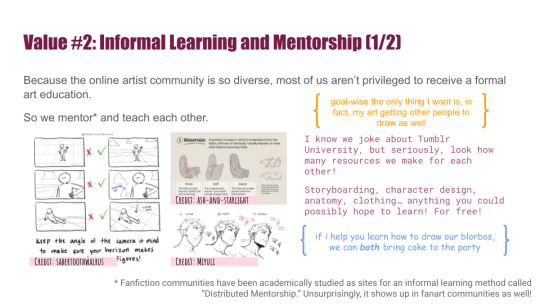
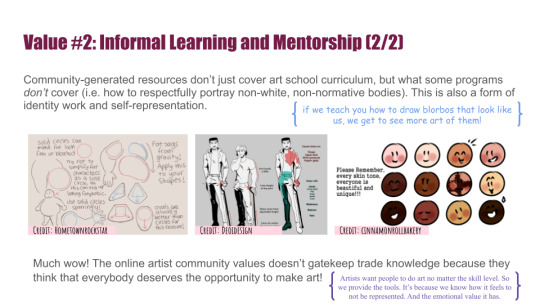
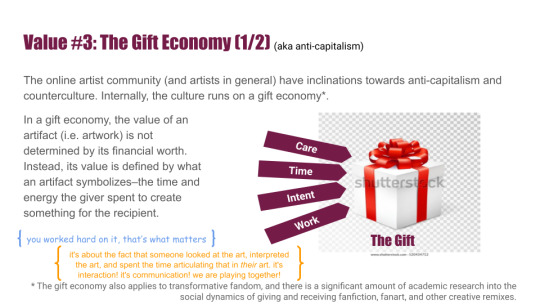
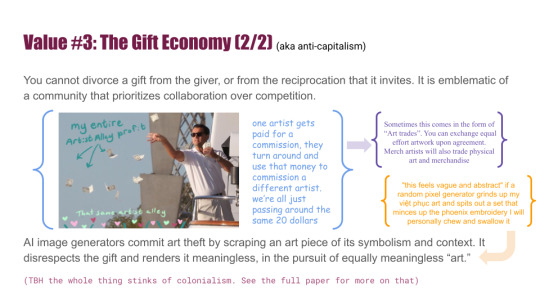
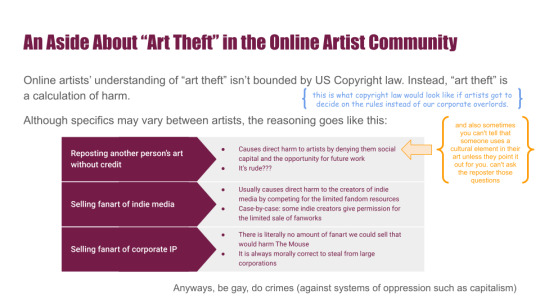
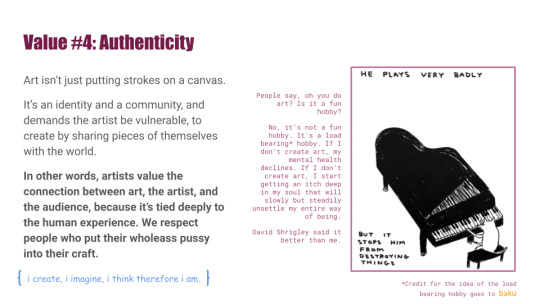
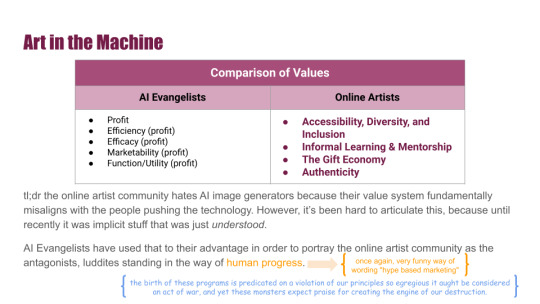
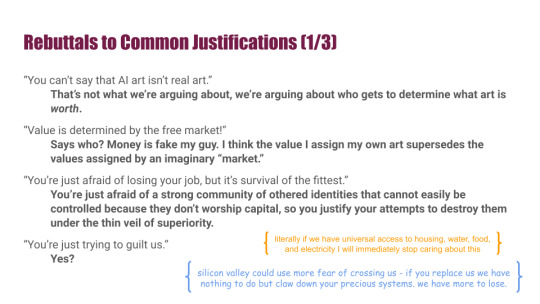
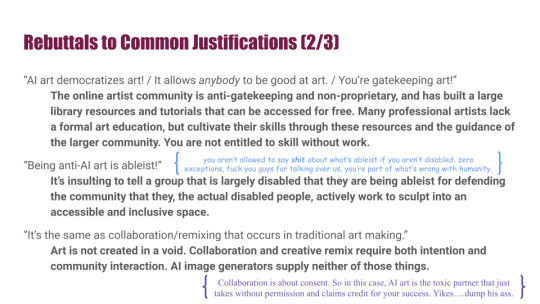
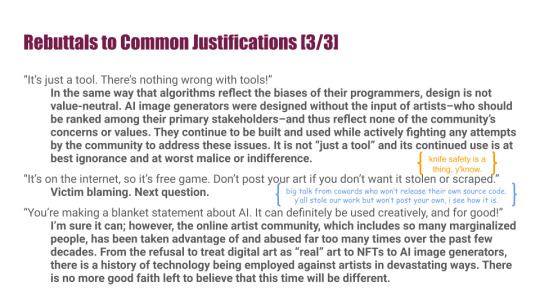
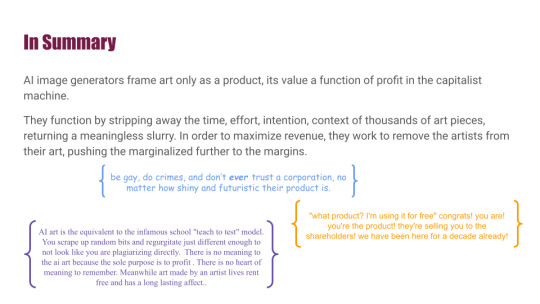
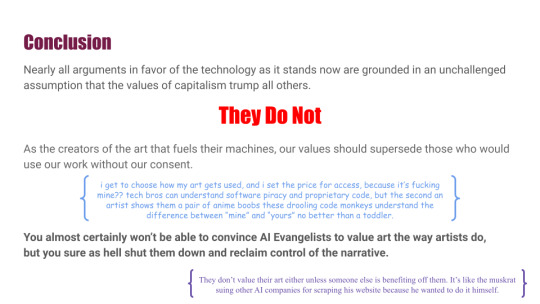
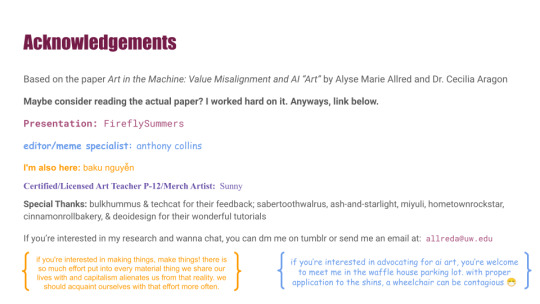
FireflySummers’ Guide to Arguing Against the Use of AI Image Generators
(AKA I hate AI image generators so fucking much that I published a whole ass academic article on it)
Read the Paper: Art in the Machine: Value Misalignment and AI "Art"
Citation: Allred, A.M., Aragon, C. (2023). Art in the Machine: Value Misalignment and AI “Art”. In: Luo, Y. (eds) Cooperative Design, Visualization, and Engineering. CDVE 2023. Lecture Notes in Computer Science, vol 14166. Springer, Cham. https://doi.org/10.1007/978-3-031-43815-8_4
The purpose of the original paper and now this post is the following:
Provide at least one academic article that you can cite. (Full paper + citation available below)
Make explicit community values that have previously been implicit, in order to better examine your own perceptions of the online artist community, and where you sit within it.
Provide rebuttals to common pro-AI talking points, with the intention of shutting down the conversation and reclaiming the narrative.
What this paper and post cannot do:
Act as a sole authority about the online artist community and its values. We are not a monolith, and it is up to you to think critically about what, exactly, you want to take away from this discussion.
Provide a way to convince AI Evangelists that what they’re doing is wrong and bad and needs to stop. You will never convince them. Again, focus on shutting them down and reclaiming the narrative.
Final Disclaimer: I'm a very fallible researcher who is still very much learning how to do academia. I cannot speak for the entirety of the online artist community or fanartist community. We all have different lived experiences. I have done my best to include diverse voices; however if you have concerns or critiques, I am open to hearing them.
If you show up to debate in favor of AI image generators, you will be automatically blocked.
Credits:
Editors, Meme Experts, and Annotators: @starbeans-bags, @b4kuch1n, @cecilioque.
Tutorial Examples: @sabertoothwalrus, @ash-and-starlight, @miyuliart, @hometownrockstar, @deoidesign, @cinnamonrollbakery
If you have read this far, thank you very much. I hope that you have found a constructive lens for approaching the war with AI image generators, as well as a new tool for shutting down debate and reclaiming the narrative.
#anti ai#fuck ai#fuck ai everything#fuck ai bros#anti ai art#ai is theft#ai is a plague#fandom#fandom research#fanart#my academics#that's a new tag for me#long post
3K notes
·
View notes
Text
Tips for Choosing the Right Image Annotation Company
Selecting the ideal image annotation company is crucial for AI and Machine Learning projects. Ensure accuracy, scalability, and expertise in diverse annotation types. Consider factors like data security, turnaround time, and customization options. Evaluate past client reviews and request sample annotations to make an informed decision tailored to your project’s unique needs. Read the article:…

View On WordPress
#image annotation#Image Annotation Company#image annotation for Machine Learning#Image Annotation Outsourcing#Image Annotation Services
0 notes
Text
0 notes
Text
Datasets for Machine Learning Projects: The Importance of Quality Data and Expert Annotation
In machine learning, the quality of your data is critical. Datasets for machine learning projects
provide the foundation for training, testing, and validating models, with sources ranging from open-source platforms to custom-built collections. High-quality datasets ensure that models perform accurately and efficiently. Data annotation, the process of labeling data, plays a crucial role in enhancing model performance by providing clear, structured information. Companies like GTS.AI offer expert Data annotation companies
, ensuring high accuracy and scalability across industries like healthcare, finance, and autonomous vehicles. By partnering with a specialized provider, you can focus on model development while ensuring top-tier data quality.
1 note
·
View note
Text
On Documenting History

I've mentioned a couple times before that the first computer I really got to use was the Sanyo MBC-1000, a Z80-based CP/M machine. In the greater picture it was a largely forgettable machine with little to differentiate it from its competitors. Which is pretty much what has happened. There are a few units sitting in museums and the odd Reddit post of someone acquiring one, but not much real information.
So last year I started taking a closer look at the machine I grew up with to try to learn what I could about how it works. And in the interest of preservation and education, I've pushed my notes to a GitHub repository.
There is much more work to be done, but so far I've made an entry-level attempt at reverse-engineering & annotating a disassembly of the boot ROM, documented all of the components on the main logic board, documented the expansion card specifications including modeling the slot and mounting brackets in freecad as well as the board outline in kicad. I've also made an effort to reverse engineer a schematic for the serial expansion card — which as far as I am currently aware is the only official expansion card that was ever produced.
I plan to continue adding notes to this repository as I learn more about this machine. It may not have made any significant historical impact, but it was a solid machine that was more than capable of doing some serious work. I believe it can still teach us something and deserves to be remembered.




I do have a secondary motive for taking such a detailed look at this machine though — at some point in the last 20 years we misplaced the box containing its boot disks and other software. I have found an old Teledisk image of an MBC-1000 boot disk which does appear to have all of the important CP/M components (like the disk format utility, sysgen, and assembler), but there is no guarantee it will work. Beyond that, its floppy drives were never terribly reliable and out-of-production magnetic media does not have much life left anyway. I want to come up with some way to attach a modern storage device to the machine to breathe new life into it (a Gotek would probably be easiest since it uses standard Shugart floppy drives, but I would love to come up with a way to give it an SD card interface or something like that). All this information will be useful for developing anything new for this machine.
33 notes
·
View notes
Text

Virtual Pathologist
Image identification by machine learning models is a major application of artificial intelligence (AI). And, with ever-improving capabilities, the use of these models for medical diagnostics and research is becoming more commonplace. Doctors analysing X-rays and mammograms, for instance, are already being assisted by AI technology, and models trained to identify signs of disease in tissue sections are also being developed to help histopathologists. The models are trained with microscope images annotated by humans – the image, for example, shows a section of rat testis with signs of tubule atrophy (pale blue shapes) with other coloured shapes indicating normal tubules and structures. Once trained, the models are tasked with categorising unannotated datasets. The latest iteration of this technology was able to identify disease in testis, ovary, prostate and kidney samples with exceptional speed and high accuracy – in some cases finding signs of disease that even trained human pathologists had missed.
Written by Ruth Williams
Image from work by Colin Greeley and colleagues
Center for Reproductive Biology, School of Biological Sciences and the School of Electrical Engineering and Computer Science Washington State University, Pullman, WA, USA
Image originally published with a Creative Commons Attribution – NonCommercial – NoDerivs (CC BY-NC-ND 4.0)
Published in Scientific Reports, November 2024
You can also follow BPoD on Instagram, Twitter and Facebook
8 notes
·
View notes